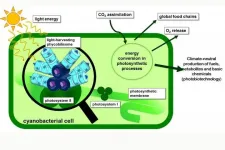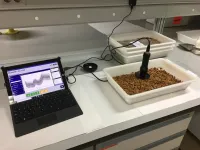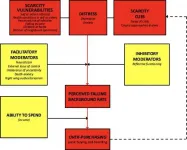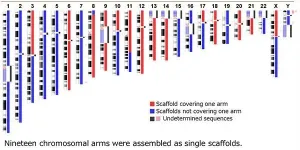Past river activity in northern Africa reveals multiple Sahara greenings
The analysis of sediment cores from the Mediterranean Sea combined with Earth system models tells the story of major environmental changes in North Africa over the last 160,000 years
2021-01-29
(Press-News.org) Large parts of today's Sahara Desert were green thousands of years ago. Prehistoric engravings of giraffes and crocodiles testify to this, as does a stone-age cave painting in the desert that even shows swimming humans. However, these illustrations only provide a rough picture of the living conditions. Recently, more detailed insights have been gained from sediment cores extracted from the Mediterranean Sea off the coast of Libya. An international research team examined these cores and discovered that the layers of the seafloor tell the story of major environmental changes in North Africa over the past 160,000 years. Cécile Blanchet of the German Research Centre for Geosciences GFZ and her colleagues from Germany, South Korea, the Netherlands and the USA report on this in the journal Nature Geoscience.
Together with the GEOMAR Helmholtz Centre for Ocean Research Kiel, a team of scientists organized a research cruise on the Dutch vessel Pelagia to the Gulf of Sirte in December 2011. "We suspected that when the Sahara Desert was green, the rivers that are presently dry would have been active and would have brought particles into the Gulf of Sirte", says lead author Cécile Blanchet. Such sediments would help to better understand the timing and circumstances for the reactivation of these rivers.
Using a method called "piston coring", the scientists were able to recover 10-meters long columns of marine mud. "One can imagine a giant hollow cylinder being pushed into the seafloor", says co-author Anne Osborne from GEOMAR, who was onboard the research ship. "The marine mud layers contain rock fragments and plant remains transported from the nearby African continent. They are also full of shells of microorganisms that grew in seawater. Together, these sediment particles can tell us the story of past climatic changes", explains Blanchet.
"By combining the sediment analyses with results from our computer simulation, we can now precisely understand the climatic processes at work to explain the drastic changes in North African environments over the past 160,000 years", adds co-author Tobias Friedrich from the University of Hawai'i.
From previous work, it was already known that several rivers episodically flowed across the region, which today is one of the driest areas on Earth. The team's unprecedented reconstruction continuously covers the last 160,000 years. It offers a comprehensive picture of when and why there was sufficient rainfall in the Central Sahara to reactivate these rivers. "We found that it is the slight changes in the Earth's orbit and the waxing and waning of polar ice sheets that paced the alternation of humid phases with high precipitation and long periods of almost complete aridity", explains Blanchet.
The fertile periods generally lasted five thousand years and humidity spread over North Africa up to the Mediterranean coast. For the people of that time, this resulted in drastic changes in living conditions, which probably led to large migratory movements in North Africa. "With our work we have added some essential jigsaw pieces to the picture of past Saharan landscape changes that help to better understand human evolution and migration history", says Blanchet. "The combination of sediment data with computer-simulation results was crucial to understand what controlled the past succession of humid and arid phases in North Africa. This is particularly important because it is expected that this region will experience intense droughts as a consequence of human-induced climate change."
INFORMATION:
[Attachments] See images for this press release:
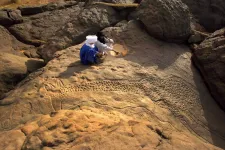
ELSE PRESS RELEASES FROM THIS DATE:
2021-01-29
The biological process of photosynthesis is found at the beginning of nearly all food chains. It produces oxygen to breathe and provides the energetic foundation for using biotechnological processes to synthesize biofuels and chemical feedstock. Therefore, researchers are particularly interested in rapidly growing cyanobacteria. These organisms use light as an energy source and can carry out photosynthesis, similar to plants. However, the required photosynthetic protein complexes bind many nutrients. Vanessa Krauspe and Prof. Dr. Wolfgang Hess from the working group for Genetics & Experimental Bioinformatics of the Faculty of Biology of ...
2021-01-29
Who hasn't at some point been chewing on an almond and tasted an unpleasant and unexpected aftertaste that has nothing to do with the taste we are used to from one of the most consumed nuts in the world? The culprit has a name: amygdalin, a diglucoside that, when in contact with enzymes present in saliva, breaks down into glucose, benzaldehyde (the cause of the bitter taste) and hydrogen cyanide.
To reduce this unpleasant 'surprise', the Farming Systems Engineering (AGR-128) and Food Technology (AGR-193) research groups at the University of Cordoba's School of Agricultural and Forestry Engineering, ...
2021-01-29
SORLA is a protein trafficking receptor that has been mainly studied in neurons, but it also plays a role in cancer cells. Professor Johanna Ivaska's research group at Turku Bioscience observed that SORLA functionally contributes to the most reported therapy-resistant mechanism by which the cell-surface receptor HER3 counteracts HER2 targeting therapy in HER2-positive cancers. Removing SORLA from cancer cells sensitized anti-HER2 resistant breast cancer brain metastasis to targeted therapy.
HER2 protein is a strong driver of tumor growth. HER2 amplification occurs ...
2021-01-29
High-intensity tropical cyclones have been moving closer to coasts over the past 40 years, potentially causing more destruction than before.
The trend of tropical cyclones - commonly known as hurricanes or typhoons - increasingly moving towards coasts over the past 40 years appears to be driven by a westward shift in their tracks, say the study's authors from Imperial College London.
While the underlying mechanisms are not clear, the team say it could be connected to changes in tropical atmospheric patterns possibly caused by climate change. The research is published today in Science.
Globally, 80 to 100 cyclones develop over tropical oceans each year, impacting regions in the Pacific, ...
2021-01-29
New research by Mimi E. Lam (University of Bergen) just published in Humanities and Social Sciences Communications identifies and explores the impacts of salient viral or COVID-19 behavioural identities that are emerging.
"These emergent COVID-19 behavioural identities are being hijacked by existing social and political identities to politicize the pandemic and heighten racism, discrimination, and conflict," says Lam. She continues: "the COVID-19 pandemic reminds us that we are not immune to each other. To unite in our fight against the pandemic, it is important to recognize the basic dignity of all and value the human diversity currently dividing us."
"Only ...
2021-01-29
Drawing on animal-foraging theory, a new model predicts psychological factors that may lead to panic buying during times of crisis. The model is largely supported by real-world data from the COVID-19 pandemic. Richard Bentall of the University of Sheffield, England, and colleagues presented these findings in the open-access journal PLOS ONE on January 27.
In the early stages of the pandemic, consumers in several countries around the world engaged in "panic buying" of household items, causing temporary shortages of toilet rolls and other products. Such behavior is typical during times of crisis, but few studies have examined the psychology of crisis-driven over-purchasing.
To better understand this phenomenon, Bentall and colleagues turned to animal-foraging ...
2021-01-29
As one of the most experienced archaeologists studying California's Native Americans, Lynn Gamble(link is external) knew the Chumash Indians had been using shell beads as money for at least 800 years.
But an exhaustive review(link is external) of some of the shell bead record led the UC Santa Barbara professor emerita of anthropology to an astonishing conclusion: The hunter-gatherers centered on the Southcentral Coast of Santa Barbara were using highly worked shells as currency as long as 2,000 years ago.
"If the Chumash were using beads as money 2,000 years ago," Gamble said, "this changes our thinking of hunter-gatherers and sociopolitical and economic complexity. This may be the first example of the use of money anywhere in the ...
2021-01-29
As part of standard patient protocol, doctors inform women of the risks of pregnancy. But there is one exception to this standard: stillbirth.
University of Arkansas law professor Jill Wieber Lens argues that women have a right to know of the risk of stillbirth, and, consistent with the evolution of informed consent law, this right should be enforceable through a medical malpractice tort claim.
Stillbirth, or pregnancy loss after 20 weeks but before birth, is not uncommon. Annually, 26,000 U.S. women give birth to a stillborn baby, or roughly one out every 160 pregnancies. The United States' stillbirth rate ...
2021-01-29
COLLEGE PARK, Md.--The amount of methane released into the atmosphere as a result of coal mining is likely much higher than previously calculated, according to research presented at the annual meeting of the American Geophysical Union recently.
The study estimates that methane emissions from coal mines are approximately 50 percent higher than previously estimated. The research was done by a team at the U.S. Department of Energy's Pacific Northwest National Laboratory, the U.S. Environmental Protection Agency and others.
The higher estimate is due mainly to two factors: methane that continues to be emitted from thousands of abandoned mines and the higher methane content in coal seams that are ever deeper, according to chief ...
2021-01-29
The Japanese now have their own reference genome thanks to researchers at Tohoku University who completed and released the first Japanese reference genome (JG1).
Their study was published in the journal Nature Communications on January 11, 2021.
"JG1 can aid with the clinical sequence analysis of Japanese individuals with rare diseases as it eliminates the genomic differences from the international reference genome," said Jun Takayama, co-author of the study.
Back in 2003, the Human Genome Project, through a gargantuan global effort, cracked the code of life and mapped all the genes of the human genome.
Since then, more accurate versions of the human reference genome have ...
LAST 30 PRESS RELEASES:
[Press-News.org] Past river activity in northern Africa reveals multiple Sahara greenings
The analysis of sediment cores from the Mediterranean Sea combined with Earth system models tells the story of major environmental changes in North Africa over the last 160,000 years

